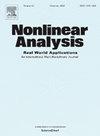Topological and control theoretic properties of Hamilton–Jacobi equations via Lax-Oleinik commutators
IF 1.8
3区 数学
Q1 MATHEMATICS, APPLIED
引用次数: 0
Abstract
In the context of weak KAM theory, we discuss the commutators and of Lax-Oleinik operators. We characterize the relation for both small time and arbitrary time . We show this relation characterizes controllability for evolutionary Hamilton–Jacobi equation. Based on our previous work on the cut locus of viscosity solution, we refine our analysis of the cut time function in terms of commutators and clarify the structure of the super/sub-level set of the cut time function .
基于Lax-Oleinik换向子的Hamilton-Jacobi方程的拓扑和控制理论性质
在弱KAM理论的背景下,我们讨论了Lax-Oleinik算子的对向子{Tt−°Tt+}t大于或等于0和{Tt+°Tt−}t大于或等于0。我们描述了在小时间和任意时间t下Tt−∘Tt+=Id的关系。我们证明了这种关系表征了进化哈密顿-雅可比方程的可控性。基于我们之前对黏性解切割轨迹的研究,我们用换向子Tt+°Tt−−Tt+°Tt−来完善对切割时间函数τ的分析,并阐明了切割时间函数τ的上/子水平集的结构。
本文章由计算机程序翻译,如有差异,请以英文原文为准。
求助全文
约1分钟内获得全文
求助全文
来源期刊
CiteScore
3.80
自引率
5.00%
发文量
176
审稿时长
59 days
期刊介绍:
Nonlinear Analysis: Real World Applications welcomes all research articles of the highest quality with special emphasis on applying techniques of nonlinear analysis to model and to treat nonlinear phenomena with which nature confronts us. Coverage of applications includes any branch of science and technology such as solid and fluid mechanics, material science, mathematical biology and chemistry, control theory, and inverse problems.
The aim of Nonlinear Analysis: Real World Applications is to publish articles which are predominantly devoted to employing methods and techniques from analysis, including partial differential equations, functional analysis, dynamical systems and evolution equations, calculus of variations, and bifurcations theory.

 求助内容:
求助内容: 应助结果提醒方式:
应助结果提醒方式:


